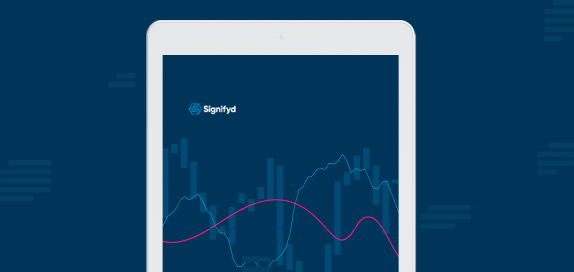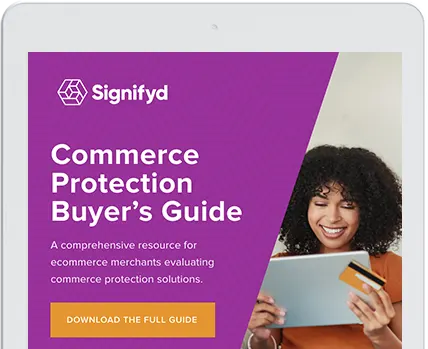Ecommerce fraud is rising. You even suspect your online store might be a specially chosen target for a fraud ring or two. So you’ve been checking out commerce protection solutions. You know it’s time.
The good news is, you have a lot of choices for ecommerce protection right now, but it pays to be cautious. And one of the things you need to watch out for when evaluating your options is the time to value of the various solutions.
This blog post, inspired by Signifyd’s Commerce Protection Buyer’s Guide, will break down the importance of time to value and how to assess it in solutions being offered.
What is time to value? It has two meanings. The first is, how soon after inking the deal do you start seeing the tangible benefits of your chosen solution? And this includes implementation time and model burn-in. After all, fraud and abuse don’t wait while you put your solution in place. How long until the system is working and producing actual results?
The longer it takes, the longer your ecommerce business is left vulnerable. A study by Signifyd took a close look at the many costs that a fraudulent transaction accrues across fulfillment and estimated the total cost of fraud at $196 for every $100 in fraudulent sales. The quicker a merchant can get a solution up and running, the quicker they stop leaking cash.
How to find rapid investment return that keeps on giving
The second definition is a little more complicated. That’s because of the nature of fraud today. Fraudsters don’t stand still. Getting your system trained on the fraud techniques happening now won’t protect you next month.
So time to value doesn’t stop once you’re up and running. You also must consider how quickly the solution can scale and adapt to new fraud landscapes. You’re going to grow. You might enter new markets. And fraudsters themselves will be coming up with new ways to get money from ecommerce merchants like you. Will your fraud solution retain value over time? On both Day 1 and Day 500?
This is the fourth in a blog series inspired by Signifyd’s Commerce Protection Buyer’s Guide. The series explores the questions that retailers and brands should ask and the factors they should consider when searching for a future-focused commerce protection platform. The series on the Signifyd blog will explore the roles of:
- Transparency
- Control
- Performance
- Time to value
We hope you find this work valuable. Feel free to reach out with your thoughts and suggestions.
Factors affecting time to market
If you are under acute fraud attacks, you need a solution right away. Like now. Here are the features to look for in solutions that will help you judge whether they will deliver quick time to market.
Pre-built integrations
Whether a provider offers pre-built integrations for your particular ecommerce platform is a key factor in the time-to-value you can expect. Otherwise, it’s necessary to code custom connections, and that takes more money — and significantly more time.
Established partnerships
Not only should a provider have established technical partnerships with all the providers in your ecommerce technology stack, they should also work with development agencies to make sure they also are familiar with the solution provider’s technologies and business outcomes. The quality of these established partnerships will determine the ability of system integrators and development agencies to seamlessly and quickly onboard your business.
Network versus merchant-specific model
Always ask what kind of risk model the solution provider offers. Network models are those that use a (usually) broad, cross-merchant network as a primary data source, while merchant-specific models are built specifically for a given merchant using its own internal data. There are critical differences between them, and network models are decidedly superior. Merchant-specific models have the following flaws:
- Longer burn-in period: Merchant-specific models require a much longer burn-in period to build, train, and return value to the merchant in comparison to the accelerated time-to-value of a network model.
- Difficulty adjusting to cross-border expansion and new market offerings: The merchant-specific model’s inflexible architecture requires a new burn-in period when merchants expand into new geographies or launch new market offerings that attract novel fraud schemes. A network-based model (like Signifyd’s) will ensure immediate future scalability.
- Operationally not scalable: Although on the surface, it seems like a merchant-specific data model is unique and special to your business, it will not keep your transaction and order flow healthy. First, it doesn’t leverage data science expertise. A specific merchant model prevents you from getting access to specialists when you need them, and certainly does not allow the specialist to be proactive — which is particularly bad when fighting fraud and optimizing payments. Second, a merchant-specific model, by its very nature, does not use data from other merchants or industries, which means fraud learnings cannot be used in one business to another. This means that any fraud attack that’s new to your business or industry, even if it was seen somewhere else, will now impact your performance negatively.
Savvy and experienced implementation team
Whatever solution you choose, you’ll need implementation project management and escalation support. Leading providers have dedicated implementation and technical account managers to help you think through your deployment. Plus, they’ll do frequent business validations and check-ins to ensure you see the value you’re looking for from the deployment. The best ones work with a range of business sizes all the way to the Samsungs, Safeways and Walmarts of the world to make sure you get the business and operational outcomes you need.
Ongoing high-quality service and support
Time-to-value is a result of both quality of tech and quality of service. Merchants should look for a provider with a dedicated team to track, measure and report on ROI. If a provider promises specific results, they should be able to back those promises with concrete numbers once you go live.
What questions should you ask when evaluating time-to-value?
Here are some questions to smoke out the particular time-to-value issues of various solutions.
- How long does implementation take?
- What is the typical time to value of your solution?
- How quick is your model to react to new fraud patterns?
- How many integration points / API calls does your integration require?
- How much historical data is required to train your solution?
- What level of effort will be expected of my team during implementation?
- How will you interact with me once we go live?
- Do you use industry-specific data or market consortium data? Why?
How Signifyd beats the competition on the time to value of ecommerce protection solutions
Signifyd is designed to provide the fastest return on your investment. Pre-built integrations, easy-to-deploy JavaScript, and network-trained models deliver out-of-the-box performance on Day 1, which is why customers rate Signifyd “Most Implementable,” “Fastest Implementation” and “Best Usability” year after year.
Signifyd AI-powered solutions maintain their value by constantly learning and because they are supported by Signifyd’s award-winning customer success team.
Photo by Getty Images
Want quick commerce protection ROI? Let’s talk.







